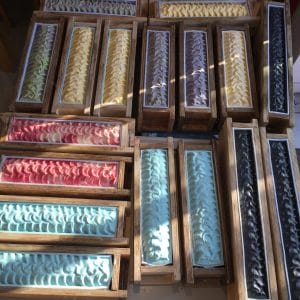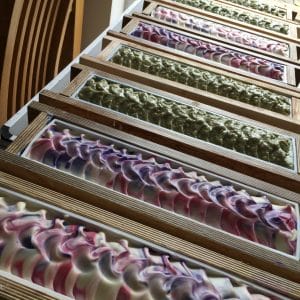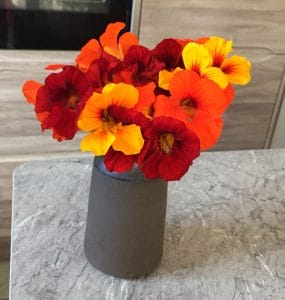Last week I set myself a challenge to make a minimum of 600 bars of soap in seven days with today (Sunday) being the last day. As well as trying to restock after a busy summer season and getting ahead for the festive season, I have a new wholesale customer who has placed a very large (for me) order that I’m steadily, but surely, fulfilling (I’ll share more about them once the first shipment has been delivered in a couple of weeks) and all that means I need to increase my rate of production. This week was a bit of an experiment in masterbatching larger amounts of oils & butters and working out how to work smarter and be more productive. That 600 bars was a fairly arbitrary goal – more than I’d ever made in one week before, but hopefully doable given my proposed new processes.
In the past, each soaping session has begun with the mixing of the lye solutions – usually enough for 8 loaves in four separate containers, which were put to one side to cool. I’d then weigh out four separate lots of hard oils & butters and melt them while also weighing out four lots of the liquid oils, ending up with four 5kg capacity buckets each containing enough prepared fats for two loaves (30 bars total) of soap. I would then go ahead and make soap, ending up with two loaves of four different varieties, giving me a total of 120 bars each full soaping session.
This week I decided to get all the oils / butters / lye prepared the night before production, and also to make more, and bigger (four loaf) batches. This gave me far more time the following day to make soap and I was able to get this lovely lot, a total of 632 bars (woop!!) made over three separate days:



So what about temperatures? I read a lot in online soaping groups that temperatures are important in the soapmaking process, but I haven’t used a thermometer since my very early days of soapy experimentation. I generally soap cool anyway, so using lye solution that was mixed the day before isn’t an issue, and I found that I needed to sit the buckets of oils & butters in some hot water in the sink for a little while to remove any granularity from the cooled hard oils. I dream of having a large insulated tank with a heating band in the future, but until then, this works really well – hooray!
Next week I aim to make as much, if not more, again. Keep rooting for me 😀
Thanks for reading, back soon!
Vicki
PS Thought I’d share this little vase of nasturtiums, freshly picked from the garden today. I have a mass of them at the bottom of the garden where they’ve self seeded and they just keep on coming, in beautiful autumnal colours. Just lovely!


Hi Vicki:
Sounds like you have come up with a good method that works for you.
Even though I make WAY less batches of soap than you do, I have been master batching oils for years. I don’t know why everyone doesn’t do it!!
I divide up 37 lbs of MB oils into 5 – 1 gallon jugs, which are easy to pop in the microwave. And if it’s something I don’t use as often (shampoo bars/salt bars), I put the gallon jugs in the freezer to stop the oils from getting old!
I still haven’t gotten up the courage to MB Lye though.
Sly
OOh I like the idea of putting prepped oils in the freezer, that’s something I should consider maybe. I always masterbatch my lye into correct ‘batch’ amounts, but I’ve seen a few people suggest making up a large amount of 1:1 solution and weighing out as much as you need per batch when you need it, diluting with water (or other liquid) in the appropriate amount. I just need to put aside the time to sit down and do the maths to work out what that appropriate amount would be!!
Very exciting! And just look at all those glorious soaps – swoooooon!!!
I’ve experimented with the 1:1 lye solution – as set out in Kevin Dunn’s scientific soapmaking book. It worked pretty well though I found, as soon as I added the extra liquid to make it up to the dilution required, it then heats up again a bit. No big deal for me as I make tiny batches and it cools down very quickly in a water bath. Rational thinking not being my strong point (!!), I worry that in the initial making of the 1:1solution as it heats up so much, what % of water evaporates? So are you still left with a 1:1? Can you tell I overthink things!!
Just this week I have experimented with the heat transfer method and I love it! Again, tiny batches – 750g so not a lot of solid oil/butter to melt – but it worked brilliantly and for some reason gave me much more ‘play time’.
Oh I’m surprised that it heats up again when you add the extra water! I have Kevin Dunn’s book too but I’ve only skimmed certain chapters, I should put the effort in and study it properly 😉 I’ve only done the heat transfer method once and while it worked really well (and saved so much time!) I found it speeded up trace significantly, which makes a big difference for me. I would like to experiment a little more with it though.